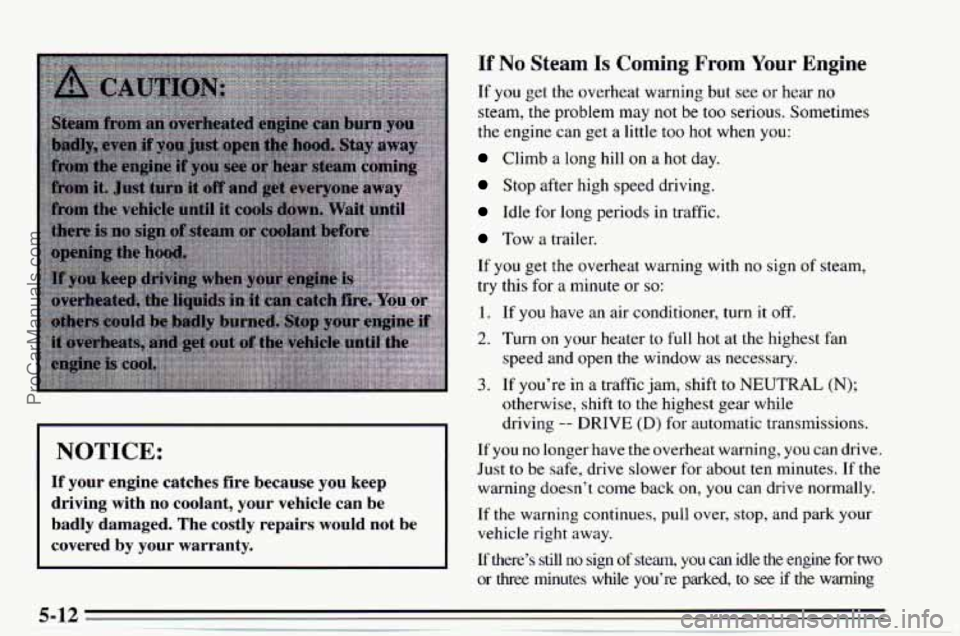Page 181 of 354
I 5. Check that the jumper cables don’t have loose or
missing insulation. If they do, you could get a shock.
The vehicles could be damaged,
too.
6. Positive (+) goes to positive (+) and negative (-)
goes to negative (-) or a metal engine part. Connect
the red positive
(+) cable to the positive (+) terminal
of the vehicle with the dead battery. Use a remote
positive
(+) terminal if the vehicle has one.
7. Don’t let the other end touch metal. Connect it to the
positive
(+) terminal of the good battery. Use a
remote positive (+) terminal if the vehicle has one.
8. Now connect the black negative (-) cable to the good
battery’s negative
(-) terminal. Don’t let the other
end touch anything until the next step.
ProCarManuals.com
Page 182 of 354
IA (-c+l
9.
10.
11.
The other end of the negative cable doesn't go to the
dead battery. It goes to a heavy unpainted metal part
on the engine
of the vehicle with the dead battery.
Attach the cable at least
18 inches (45 cm) away
from the dead battery, but not near engine parts that
move. The electrical connection
is just as good there,
but
the chance of sparks getting back to the battery is
much less.
Now start the vehicle with the good battery and run
the engine for a while.
Try to start the vehicle with the dead battery. If it won't
start after a few tries, it probably needs service.
12. Remove the cables in reverse order to prevent
electrical shorting. Take care that they don't touch
each other
or any other metal.
A. Heavy Metal Engine Part
B. Good Battery
C. Dead Battery
ProCarManuals.com
Page 188 of 354
c
3. Attach a separate safety chain around the outboard
end
of each side of the rear axle.
Engine Overheating
You will find a coolant temperature gage on your Geo
instrument panel.
If Steam Is Coming From Your Engine
ProCarManuals.com
Page 189 of 354

If No Steam Is Coming From Your Engine
I NOTICE:
If your engine catches fire because you keep
driving with no coolant, your vehicle can be
badly damaged. The costly repairs would not be
covered by your warranty.
If you get the overheat warning but see or hear no
steam,
the problem may not be too serious. Sometimes
the engine can get a little too hot when you:
Climb a long hill on a hot day.
Stop after high speed driving.
Idle for long periods in traffic.
Tow a trailer.
If
you get the overheat warning with no sign of steam,
try this for a minute or
so:
1. If you have an air conditioner, turn it off.
2. Turn on your heater to full hot at the highest fan
speed and open the window as necessary.
3. If you’re in a traffic jam, shift to NEUTRAL (N);
otherwise, shift to the highest gear while
driving
-- DRIVE (D) for automatic transmissions.
If you no longer have the overheat warning, you can drive.
Just to be safe, drive slower for about ten minutes. If the
warning doesn’t come back on,
you can drive normally.
If the warning continues, pull over, stop, and park your
vehicle right away.
If there’s still
no sign of steam, you can idle the engine for two
or
three minutes while you’re parked, to see if the warning
ProCarManuals.com
Page 190 of 354
stops. But then, if you still have the warning, turn ofthe
engine
and get everyone out of the vehicle until it cools down.
You may decide not to lift the hood but to get service
help right away.
2. Radiator Pressure Cap
3. Electric Engine Fan
Cooling System
When you decide it’s safe to lift the hood, here’s what
you’ll see on the 8-valve engine:
1. Coolant Recovery Tank Here’s what
you’ll see on the 16-valve engine:
1. Coolant Recovery Tank
2. Radiator Pressure Cap
3. Electric Engine Fan
ProCarManuals.com
Page 192 of 354
NOTICE:
Engine damage from running your engine
without coolant isn’t covered by
your warranty.
If there seems to be no leak, with the engine on check to
see if the electric engine fan is running. If the engine is
overheating, the fan should be running.
If it isn’t, your
vehicle needs service.
How to Add Coolant to the Coolant
Recovery Tank
If you haven’t found a problem yet, but the coolant level
isn’t at
or above the FULL mark, add a 50 mixture of
clean water (preferably distilled) and a proper antifreeze
at the coolant recovery tank. (See “Engine Coolant”
in
the Index for more information about the proper coolant
mix.)
ProCarManuals.com
Page 193 of 354
I NOTICE:
In cold weather, water can freeze and crack the
engine, radiator, heater core and other parts. Use
the recommended coolant.
When the coolant in the coolant recovery tank is at or
above the
FULL mark, start your vehicle.
If the overheat warning continues, there's one more
thing
you can try. You can add the proper coolant mix
directly to the radiator, but be sure the cooling system is
cool before you do it.
ProCarManuals.com
Page 197 of 354
6. Start the engine and let it run until you can feel the
upper radiator hose getting hot. Watch out for the
engine fan.
7. By this time the coolant level inside the radiator
filler neck may be lower.
If the level is lower, add
more
of the proper mix through the filler neck until
the level reaches the base of the filler neck.
8. Then replace the pressure cap. At any time during
this procedure
if coolant begins to flow out of the
filler neck, reinstall the pressure cap. Be sure the
arrows on the pressure cap line up like this.
5-20 ~ - . . I .. - -- . . .,.^. . . .. ProCarManuals.com